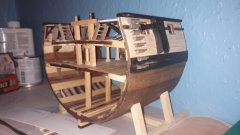
Bob Cleek
-
Posts
3,374 -
Joined
-
Last visited
Reputation Activity
-
 Bob Cleek got a reaction from Canute in Wood filler recommendations
Bob Cleek got a reaction from Canute in Wood filler recommendations
Recognizing that I may be sticking my neck out here, I'll offer the comment that the warnings seen on many solvent-based materials these days exist more for the manufacturer's' protection against products liability lawsuits which often result from the misuse of the product than for the protection of folks who use the product "as directed for the use intended." If you read the warnings now printed on a common ladder, you'd never climb one again. This phenomenon has created a certain level of paranoia in the general public, many of whom shy away from anything that has an odor they've been conditioned to find disagreeable. While chemistry continues to make progress in developing non-solvent-based materials, in most instances these substitute "water-based" materials intended to replace long-established solvent-based materials are inferior to their solvent-based predecessors, particularly with respect to their archival qualities, an important consideration in modeling. When used as directed, meaning "in a well-ventilated workspace" and in the small amounts encountered in modeling, there is generally negligible risk in using solvent-based materials. Commonsense is the order of the day in this respect. Without question, pouring an excessive amount of solvent-based material in a paper bag and "huffing" it is hazardous to your health, but we aren't contemplating that sort of misuse. Sadly, the general public's conditioned reaction to these product warnings has reduced the marketability of valuable materials and chased many manufacturers out of the marketplace entirely. (The demise of Floquil paints being a prime example.) In jurisdictions like California, which requires warning labels on anything that "may cause cancer or birth defects," we find state-mandated warning labels to that effect on everything from gasoline to wine and many long-valued solvent-based products can no longer be legally purchased at all. Local "product safety" ordinances in some California "air quality districts" even go so far as to outlaw the sale of any volatile organic compounds above a certain content limit including simple oil-based enamel paint or paint thinner and the like and, consequently, all that can be purchased anymore are inferior water-based coatings. Mindfulness of shop safety is a good thing, but we should not "throw the baby out with the bath water." Otherwise, we will continue to find valuable materials becoming entirely unavailable to the detriment of our craft.
That said, Bondo is a hygroscopic material intended for use on dented automotive body metal and is not intended for nor suitable for use on wooden surfaces.
-
 Bob Cleek reacted to rshousha in Value-for-Money Airbrush
Bob Cleek reacted to rshousha in Value-for-Money Airbrush
Our industry is very small, whether buyers, sellers, or manufacturers. If we want to encourage some small manufacturers to invest in machinery to make products locally, we have to lead by example, and buy locally-made products. Otherwise, if we are always looking for the cheapest solution, manufacturers will have little incentive to invest, create jobs, innovate, and feed our industry.
-
 Bob Cleek reacted to kurtvd19 in Value-for-Money Airbrush
Bob Cleek reacted to kurtvd19 in Value-for-Money Airbrush
Harry:
I one buys a brand name there isn't a need to find a source of parts.
Kurt
-
 Bob Cleek got a reaction from rshousha in Value-for-Money Airbrush
Bob Cleek got a reaction from rshousha in Value-for-Money Airbrush
Kurt's comments are worth a "sticky."
We are vigilant when it comes to pirated model kits, but piracy doesn't end with model kits. One of the "most-pirated" aspects of modeling are the tools we use.
-
 Bob Cleek got a reaction from BETAQDAVE in Split ring making process
Bob Cleek got a reaction from BETAQDAVE in Split ring making process
You forget the last three ring making steps:
Drop the completed ring on the floor.
Spend fifteen minutes looking for it while talking dirty before giving up.
Repeat.
-
 Bob Cleek got a reaction from FriedClams in SMS WESPE 1876 by wefalck – 1/160 scale - Armored Gunboat of the Imperial German Navy - as first commissioned
Bob Cleek got a reaction from FriedClams in SMS WESPE 1876 by wefalck – 1/160 scale - Armored Gunboat of the Imperial German Navy - as first commissioned
Beautiful work! I think you are channeling Donald McNarry's ghost!
-
 Bob Cleek got a reaction from mtaylor in SMS WESPE 1876 by wefalck – 1/160 scale - Armored Gunboat of the Imperial German Navy - as first commissioned
Bob Cleek got a reaction from mtaylor in SMS WESPE 1876 by wefalck – 1/160 scale - Armored Gunboat of the Imperial German Navy - as first commissioned
Beautiful work! I think you are channeling Donald McNarry's ghost!
-
 Bob Cleek reacted to Snug Harbor Johnny in Split ring making process
Bob Cleek reacted to Snug Harbor Johnny in Split ring making process
'Gosh - I forgot about how I used to make rings for chain mail ... That was to wrap coat hanger wire around a 1'2" rod to make a coil, then cut off links with aviation snips. Yeah, the ends weren't flush - but a couple passes with a file would smooth things. Now TINY rings are another matter, but using small 'flush cutters' on brass wire would leave one side nearly flat. But if the best flatness is desired, the sawing method sounds like a plan.
There are fine saws for cutting 'tubular' (or other) metal model train tracks that are rigidly backed.
-
 Bob Cleek got a reaction from Canute in Painting to retain laser cut detail
Bob Cleek got a reaction from Canute in Painting to retain laser cut detail
You may find less warping problems if you thin your acrylic paint with alcohol. Experiment with scrap material to be sure this will work with your particular paper and paint.
I think the task you describe would be best accomplished by using an airbrush. "Full bodied acrylics from a little pot" are not the best for retaining detail. Retaining detail requires a light application of thin paint, generally in multiple thin coats.
-
 Bob Cleek got a reaction from DelF in Split ring making process
Bob Cleek got a reaction from DelF in Split ring making process
You forget the last three ring making steps:
Drop the completed ring on the floor.
Spend fifteen minutes looking for it while talking dirty before giving up.
Repeat.
-
 Bob Cleek got a reaction from thibaultron in Painting to retain laser cut detail
Bob Cleek got a reaction from thibaultron in Painting to retain laser cut detail
You may find less warping problems if you thin your acrylic paint with alcohol. Experiment with scrap material to be sure this will work with your particular paper and paint.
I think the task you describe would be best accomplished by using an airbrush. "Full bodied acrylics from a little pot" are not the best for retaining detail. Retaining detail requires a light application of thin paint, generally in multiple thin coats.
-
 Bob Cleek got a reaction from Canute in Split ring making process
Bob Cleek got a reaction from Canute in Split ring making process
You forget the last three ring making steps:
Drop the completed ring on the floor.
Spend fifteen minutes looking for it while talking dirty before giving up.
Repeat.
-
 Bob Cleek reacted to Dr PR in Split ring making process
Bob Cleek reacted to Dr PR in Split ring making process
If you are using very small diameter wire just cut it with a hobby knife and a chisel blade (square ended). Fasten the drill bit in a vice and support the bit and wire coil before trying to cut. It really doesn't matter if the cuts run straight down the drill bit because all of the rings will be the same diameter in any case.
For soldering use a tiny bit of liquid solder flux in the gap (use a small paint brush). Then put a tiny bit of solder on the soldering iron tip and touch it to the joint. The flux will pull the solder into the joint. You should be able to pull the soldering iron tip away and have it carry any excess solder. You may get a tiny "spike" where the tip pulled away, but that can be removed with a file. Or wipe the soldering iron tip clean on a wet sponge and touch the joint again to carry away more solder.
I can't see a resistance soldering iron having any advantage in this case. You need two separate electrical circuits at the gap between the two pieces to be soldered in order to generate current flow and heat in the gap. The tiny ring is a low resistance loop between the ends to be soldered so there would be no potential difference between the ends of the ring and no current flow in the gap. The heat would be generated between the soldering tip and the metal ring, and not in the gap between the ring ends. This is no different from just using an ordinary hot tip soldering iron.
-
 Bob Cleek got a reaction from davyboy in Split ring making process
Bob Cleek got a reaction from davyboy in Split ring making process
You forget the last three ring making steps:
Drop the completed ring on the floor.
Spend fifteen minutes looking for it while talking dirty before giving up.
Repeat.
-
 Bob Cleek got a reaction from Chuck Seiler in Split ring making process
Bob Cleek got a reaction from Chuck Seiler in Split ring making process
You forget the last three ring making steps:
Drop the completed ring on the floor.
Spend fifteen minutes looking for it while talking dirty before giving up.
Repeat.
-
 Bob Cleek got a reaction from Gregory in Split ring making process
Bob Cleek got a reaction from Gregory in Split ring making process
You forget the last three ring making steps:
Drop the completed ring on the floor.
Spend fifteen minutes looking for it while talking dirty before giving up.
Repeat.
-
 Bob Cleek got a reaction from Edwardkenway in Split ring making process
Bob Cleek got a reaction from Edwardkenway in Split ring making process
You forget the last three ring making steps:
Drop the completed ring on the floor.
Spend fifteen minutes looking for it while talking dirty before giving up.
Repeat.
-
 Bob Cleek got a reaction from TBlack in Split ring making process
Bob Cleek got a reaction from TBlack in Split ring making process
You forget the last three ring making steps:
Drop the completed ring on the floor.
Spend fifteen minutes looking for it while talking dirty before giving up.
Repeat.
-
 Bob Cleek got a reaction from Roger Pellett in Split ring making process
Bob Cleek got a reaction from Roger Pellett in Split ring making process
You forget the last three ring making steps:
Drop the completed ring on the floor.
Spend fifteen minutes looking for it while talking dirty before giving up.
Repeat.
-
 Bob Cleek got a reaction from mtaylor in Painting to retain laser cut detail
Bob Cleek got a reaction from mtaylor in Painting to retain laser cut detail
You may find less warping problems if you thin your acrylic paint with alcohol. Experiment with scrap material to be sure this will work with your particular paper and paint.
I think the task you describe would be best accomplished by using an airbrush. "Full bodied acrylics from a little pot" are not the best for retaining detail. Retaining detail requires a light application of thin paint, generally in multiple thin coats.
-
 Bob Cleek got a reaction from mtaylor in Split ring making process
Bob Cleek got a reaction from mtaylor in Split ring making process
You forget the last three ring making steps:
Drop the completed ring on the floor.
Spend fifteen minutes looking for it while talking dirty before giving up.
Repeat.
-
 Bob Cleek got a reaction from shipman in Split ring making process
Bob Cleek got a reaction from shipman in Split ring making process
You forget the last three ring making steps:
Drop the completed ring on the floor.
Spend fifteen minutes looking for it while talking dirty before giving up.
Repeat.
-
 Bob Cleek reacted to DonBMichigan in Wood filler recommendations
Bob Cleek reacted to DonBMichigan in Wood filler recommendations
After taking a few days off to think about it, and read responses, I did remove the old piece and make a new one that I'm happy with. 🙂
-
 Bob Cleek got a reaction from Dsmith20639 in Wood filler recommendations
Bob Cleek got a reaction from Dsmith20639 in Wood filler recommendations
Recognizing that I may be sticking my neck out here, I'll offer the comment that the warnings seen on many solvent-based materials these days exist more for the manufacturer's' protection against products liability lawsuits which often result from the misuse of the product than for the protection of folks who use the product "as directed for the use intended." If you read the warnings now printed on a common ladder, you'd never climb one again. This phenomenon has created a certain level of paranoia in the general public, many of whom shy away from anything that has an odor they've been conditioned to find disagreeable. While chemistry continues to make progress in developing non-solvent-based materials, in most instances these substitute "water-based" materials intended to replace long-established solvent-based materials are inferior to their solvent-based predecessors, particularly with respect to their archival qualities, an important consideration in modeling. When used as directed, meaning "in a well-ventilated workspace" and in the small amounts encountered in modeling, there is generally negligible risk in using solvent-based materials. Commonsense is the order of the day in this respect. Without question, pouring an excessive amount of solvent-based material in a paper bag and "huffing" it is hazardous to your health, but we aren't contemplating that sort of misuse. Sadly, the general public's conditioned reaction to these product warnings has reduced the marketability of valuable materials and chased many manufacturers out of the marketplace entirely. (The demise of Floquil paints being a prime example.) In jurisdictions like California, which requires warning labels on anything that "may cause cancer or birth defects," we find state-mandated warning labels to that effect on everything from gasoline to wine and many long-valued solvent-based products can no longer be legally purchased at all. Local "product safety" ordinances in some California "air quality districts" even go so far as to outlaw the sale of any volatile organic compounds above a certain content limit including simple oil-based enamel paint or paint thinner and the like and, consequently, all that can be purchased anymore are inferior water-based coatings. Mindfulness of shop safety is a good thing, but we should not "throw the baby out with the bath water." Otherwise, we will continue to find valuable materials becoming entirely unavailable to the detriment of our craft.
That said, Bondo is a hygroscopic material intended for use on dented automotive body metal and is not intended for nor suitable for use on wooden surfaces.
-
 Bob Cleek got a reaction from DonBMichigan in Wood filler recommendations
Bob Cleek got a reaction from DonBMichigan in Wood filler recommendations
Recognizing that I may be sticking my neck out here, I'll offer the comment that the warnings seen on many solvent-based materials these days exist more for the manufacturer's' protection against products liability lawsuits which often result from the misuse of the product than for the protection of folks who use the product "as directed for the use intended." If you read the warnings now printed on a common ladder, you'd never climb one again. This phenomenon has created a certain level of paranoia in the general public, many of whom shy away from anything that has an odor they've been conditioned to find disagreeable. While chemistry continues to make progress in developing non-solvent-based materials, in most instances these substitute "water-based" materials intended to replace long-established solvent-based materials are inferior to their solvent-based predecessors, particularly with respect to their archival qualities, an important consideration in modeling. When used as directed, meaning "in a well-ventilated workspace" and in the small amounts encountered in modeling, there is generally negligible risk in using solvent-based materials. Commonsense is the order of the day in this respect. Without question, pouring an excessive amount of solvent-based material in a paper bag and "huffing" it is hazardous to your health, but we aren't contemplating that sort of misuse. Sadly, the general public's conditioned reaction to these product warnings has reduced the marketability of valuable materials and chased many manufacturers out of the marketplace entirely. (The demise of Floquil paints being a prime example.) In jurisdictions like California, which requires warning labels on anything that "may cause cancer or birth defects," we find state-mandated warning labels to that effect on everything from gasoline to wine and many long-valued solvent-based products can no longer be legally purchased at all. Local "product safety" ordinances in some California "air quality districts" even go so far as to outlaw the sale of any volatile organic compounds above a certain content limit including simple oil-based enamel paint or paint thinner and the like and, consequently, all that can be purchased anymore are inferior water-based coatings. Mindfulness of shop safety is a good thing, but we should not "throw the baby out with the bath water." Otherwise, we will continue to find valuable materials becoming entirely unavailable to the detriment of our craft.
That said, Bondo is a hygroscopic material intended for use on dented automotive body metal and is not intended for nor suitable for use on wooden surfaces.










